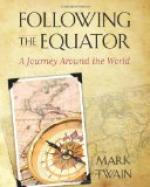from clime to clime, from hemisphere to hemisphere,
in contentment and comfort, in virile interest
in the constant change Of scene, in humble thankfulness
for its privileges, in ever-increasing enthusiasm
in the development of the great theory upon whose
validity it had staked its life, its fortunes,
and its sacred honor, if I may use such expressions
without impropriety in connection with an episode
of this nature.
“It lived the tranquil and luxurious life of a creature of independent means. Of things actually necessary to its existence and its happiness not a detail was wanting. When it wished to walk, it scrambled along the tree-trunk; it mused in the shade of the leaves by day, it slept in their shelter by night; when it wanted the refreshment of a swim, it had it; it ate leaves when it wanted a vegetable diet, it dug under the bark for worms and grubs; when it wanted fish it caught them, when it wanted eggs it laid them. If the grubs gave out in one tree it swam to another; and as for fish, the very opulence of the supply was an embarrassment. And finally, when it was thirsty it smacked its chops in gratitude over a blend that would have slain a crocodile.
“When at last, after thirteen months of travel and research in all the Zones it went aground on a mountain-summit, it strode ashore, saying in its heart, ’Let them that come after me invent theories and dream dreams about the Survival of the Fittest if they like, but I am the first that has done it!
“This wonderful creature dates back like the kangaroo and many other Australian hydrocephalous invertebrates, to an age long anterior to the advent of man upon the earth; they date back, indeed, to a time when a causeway hundreds of miles wide, and thousands of miles long, joined Australia to Africa, and the animals of the two countries were alike, and all belonged to that remote geological epoch known to science as the Old Red Grindstone Post-Pleosaurian. Later the causeway sank under the sea; subterranean convulsions lifted the African continent a thousand feet higher than it was before, but Australia kept her old level. In Africa’s new climate the animals necessarily began to develop and shade off into new forms and families and species, but the animals of Australia as necessarily remained stationary, and have so remained until this day. In the course of some millions of years the African Ornithorhynchus developed and developed and developed, and sluffed off detail after detail of its make-up until at last the creature became wholly disintegrated and scattered. Whenever you see a bird or a beast or a seal or an otter in Africa you know that he is merely a sorry surviving fragment of that sublime original of whom I have been speaking—that creature which was everything in general and nothing in particular—the opulently endowed ‘e pluribus unum’ of the animal world.
“Such is the history
of the most hoary, the most ancient, the most
venerable creature that
exists in the earth today—Ornithorhynchus
Platypus Extraordinariensis—whom
God preserve!”




